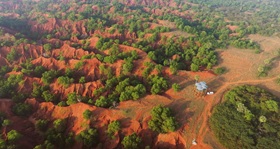21 September, 2025
Erra Matti Dibbalu
Mon 15 Sep, 2025
Context
Erra Matti Dibbalu, also known as the Red Sand Dunes, located near Visakhapatnam in Andhra Pradesh, has been included in the UNESCO Tentative List of World Heritage Sites. These rare coastal geomorphological formations offer invaluable insights into Earth’s evolutionary and climatic history.
Geological Significance
- Location: Erra Matti Dibbalu is situated along the Bay of Bengal, near Bheemunipatnam in Visakhapatnam district, Andhra Pradesh.
- Discovery: British geologist William King first documented the formations in 1886.
- Composition: The site consists of sand, silt, and clay. The distinct reddish colour is due to natural oxidation over thousands of years.
- Age: The red sediments belong to the Late Quaternary Period, providing records of sea-level fluctuations and climate change over 20,000 years.
Unique Geomorphological Features
The Erra Matti Dibbalu region showcases badland topography, including:
- Gullies
- Buried channels
- Paired terraces
- Wave-cut terraces
- Valley-in-valley formations
- Knick points
- Waterfalls
These features help geologists interpret sediment transport, erosional patterns, and paleo-climatic variations over millennia.
Archaeological & Climate Relevance
- Paleolithic Artefacts: Excavations indicate the presence of an Upper Paleolithic horizon, dating back to the Late Pleistocene epoch (around 20,000 BCE).
- Climate Change Evidence: Sediment layers and dendritic drainage patterns record major environmental transitions including sea-level rise, coastal erosion, and monsoonal changes.
- Live Evolution Site: It is considered a live lab for observing the real-time effects of coastal geomorphic evolution and climate stress.
Why it is Nominated for UNESCO Status
| Feature | Relevance to UNESCO Criteria |
| Unique Landforms | Rare red sediment formations shaped by natural oxidation |
| Scientific Value | Important site for geo-climate evolution and archaeology |
| Cultural Relevance | Holds traces of early human habitation |
| Environmental Education | Ideal for research, conservation awareness and eco-tourism |
| Threatened Ecosystem | Vulnerable to unregulated tourism, film shoots, and erosion |
Challenges
- Unregulated Tourism: Film shooting and tourism activities are damaging the fragile formations.
- Lack of Monitoring: No regular tracking of sediment loss or structural integrity.
- Need for Conservation: Scientific zoning, limited visitor access, and digital mapping are needed.
Major UNESCO World Heritage Sites in India (Selected List)
| Site Name | Location | Category |
| Taj Mahal | Uttar Pradesh | Cultural |
| Ellora Caves | Maharashtra | Cultural |
| Konark Sun Temple | Odisha | Cultural |
| Kaziranga National Park | Assam | Natural |
| Sundarbans National Park | West Bengal | Natural |
| Chola Temples | Tamil Nadu | Cultural |
| Khangchendzonga National Park | Sikkim | Mixed (C+N) |
| Western Ghats | Kerala/Karnataka etc. | Natural |
| Champaner-Pavagadh Archaeological Park | Gujarat | Cultural |
| Rani-ki-Vav (Queen’s Stepwell) | Gujarat | Cultural |


















